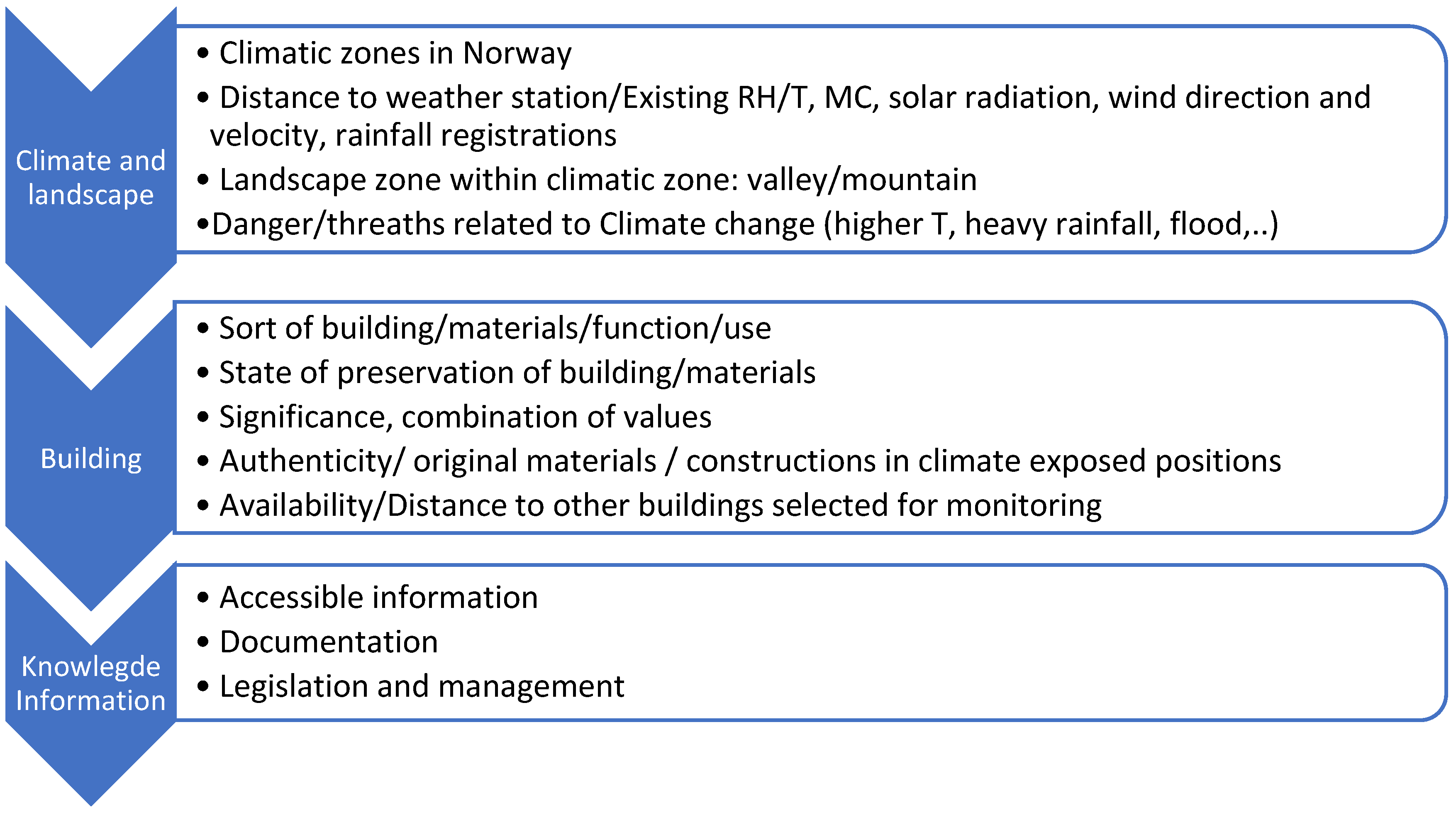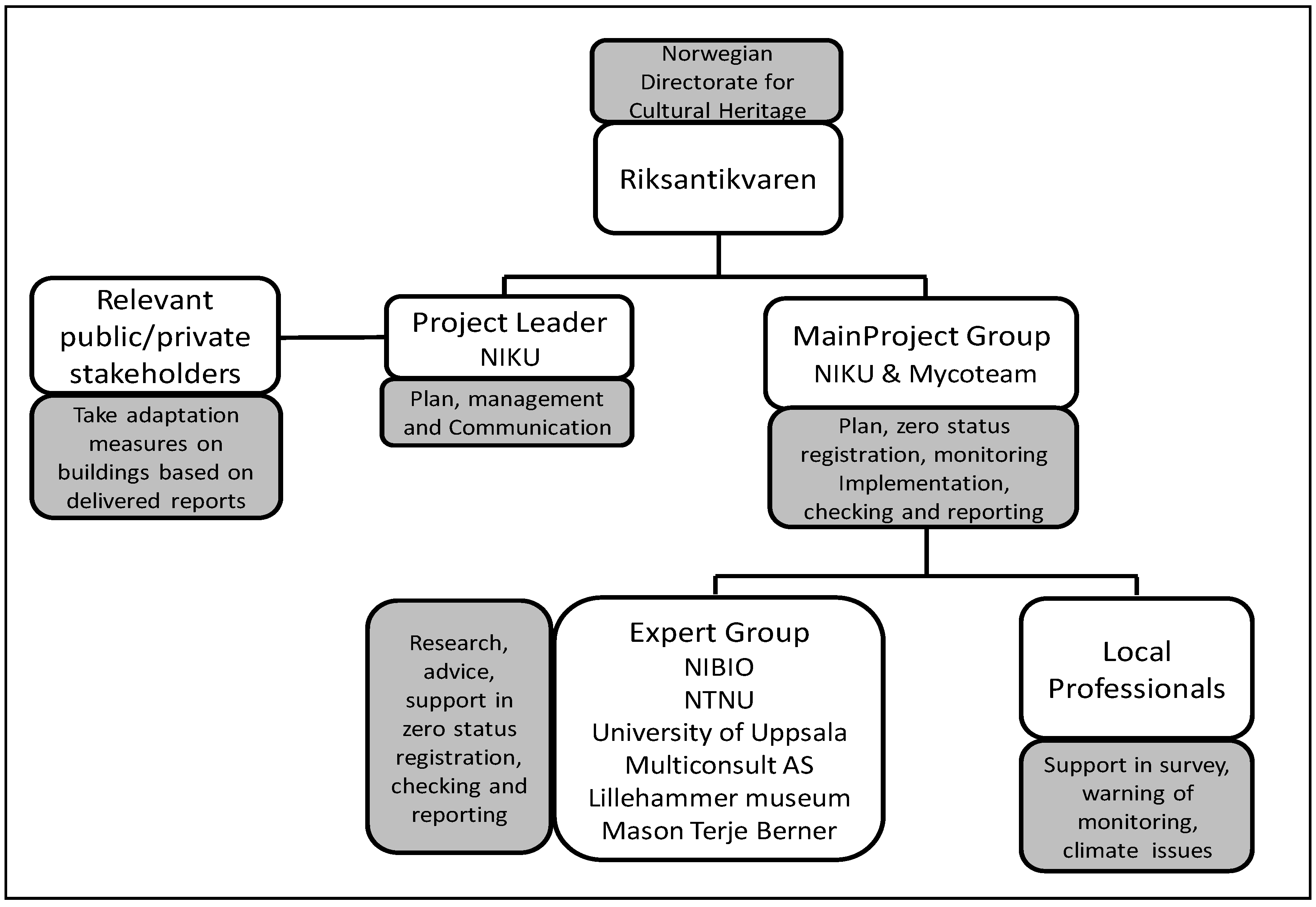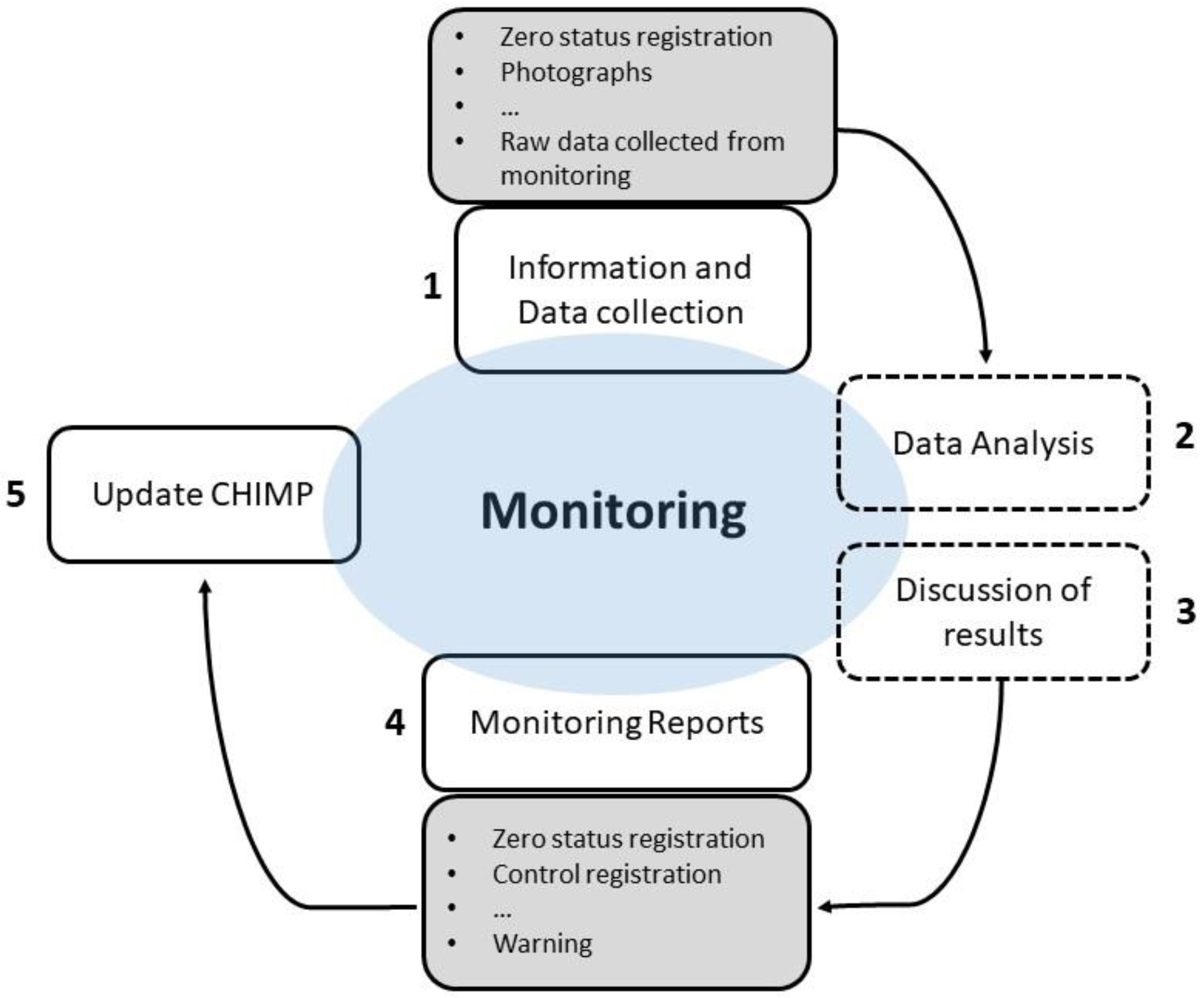A Methodology for Long-Term Monitoring of Climate Change Impacts on Historic Buildings
Abstract
:1. Introduction
State-Of-The-Art
- (1)
- definition of the system of interest,
- (2)
- selection of a set of indicators,
- (3)
- identification of the organizations responsible for monitoring,
- (4)
- definition of monitoring and evaluation procedures.
2. Materials and Methods
2.1. Development of a Method for the Long-Term Monitoring of Climate Change Impacts on Cultural Heritage
2.1.1. A Generic Framework for Developing Monitoring Programs
- Understanding the historic building through the collection of data on location, type of immovable cultural heritage, type of material and state of preservation, and statement of significance, authenticity, and integrity to understand aspects to be safeguarded.
- Understanding the hazards, i.e., dangers and threats to the area including those induced by climate change, use of the building, existing policies, strategies, plans, and actions that are of relevance for preventive conservation and maintenance.
- Understanding the instruments of safeguarding, i.e., national law, legislation, local regulations, international conventions/charters, and, later in the project, to understand if these instruments have to be adapted or new ones have to be developed.
- The overall vision and general objectives of the monitoring: (1) understanding the field of actions (i.e., adaptation of cultural heritage to climate change effects by minimizing their negative impacts); (2) acquaintance with the state-of-the-art, i.e., identification of relevant issues to deal with (e.g., weathering of historic fabric, preventive and adaptation measures in response to climate change), and, consequently; (3) objectives to achieve and strategies (integrated approach).
- The understanding of how to achieve the goals, i.e., identifying the environmental variables, actions, instruments, and techniques (both existing and to be developed with a main focus on a non-destructive technique (NDT)) to accomplish the objectives of the long-term monitoring. These are the outputs achieved as the recognition of alterations ascribed to climate change when compared to the zero status registration.
- Plan: Development and/or adaptation of organizational and operational structures and procedures clearly allocating responsibilities and tasks to be met (e.g., through an organigram that explains a responsible body/person and sets the individual goals for: (1) safeguarding the cultural heritage values, (2) the implementation, application, and revision of monitoring and data collection, and (3) assuring that actions are taken in time, according to monitoring results.
- Do: Implementation plan and execution phase of long-term monitoring. The implementation plan includes a sequence of actions (i.e., tasks and activities as systems for collection and storage of data, reporting and management, etc.), which have to be executed (e.g., who is doing what, what inputs are needed, what outputs are intended, etc.). Additionally, the collection of information concerning the assessment of the building or structure to define the so-called zero-level registration condition (step 1) has to be concluded before starting the monitoring (execution phase). This defined state will be the base for the future assessments and registrations of the object that is to be monitored. In this phase, a close communication with the institution that is managing the historic buildings is needed.
- Check: Continuous monitoring and review (e.g., description of who is monitoring or evaluating what and how results will be used). This checking or review stage will strengthen the evidence base in time for the next cycle of reporting so that the historic building will be better served by the method/process itself.
- Act: Acting to adapt historic buildings to climate change effects on the basis of monitoring results. In the long-term perspective, the program will evaluate adaptive measures that have been proposed and eventually implemented by directly or indirectly monitoring them.
2.1.2. Suggested Monitoring Method
2.1.2.1. The Climate Panels
2.1.2.2. The Reports
3. Results
3.1. Implementation of the Method in a Monitoring Program in Norway and the First Results
3.1.1. Selection of Buildings
- Skoger Old Church, which is a stone church dating to around 1200 and is located in the inland region near Oslo.
- Raulandstua, which is a timber building dating to 1238, which has been hosted at the Oslo open-air museum since 1899.
- Garmo stave church, see Figure 5, which is a wooden building originally dating to early 1200 and is now hosted at the Maihaugen museum, Lillehammer, in the inland region north of Oslo. It was erected at the museum in 1921.
- Bugarden, which is a wooden 18th century building at the World Heritage Site of Bryggen (the Wharf) in Bergen on the west coast.
3.1.2. Organization
3.1.3. Choice of Indicators
3.1.4. The Zero-Level Condition Survey
3.1.5. Information Storage and Access
3.1.6. Future Plans for the Monitoring Project
4. Discussion and Conclusions
Author Contributions
Funding
Conflicts of Interest
References
- Klein, R.; Smith, J. Enhancing the capacity of developing countries to adapt to climate change: A policy relevant research agenda. In Climate Change, Adaptive Capacity and Development; Smith, J., Klein, R., Huq, S., Eds.; Imperial College Press: London, UK, 2003. [Google Scholar]
- Smit, B.; Burton, I.; Klein, R.J.T.; Street, R. The science of adaptation: A framework for assessment. Mitig. Adapt. Strat. Glob. Chang. 1999, 4, 199–213. [Google Scholar] [CrossRef]
- Leissner, J.; Kilian, R.; Kotova, L.; Jacob, D.; Mikolajewicz, U.; Broström, T.; Ashley Smith, J.; Schellen, H.; Martens, M.; van Schijndel, J.; et al. Climate for culture—Assessing the impact of climate change on the future indoor climate in historic buildings using simulations. Herit. Sci. 2015, 3, 38. [Google Scholar] [CrossRef]
- Sabbioni, C.; Brimblecombe, P.; Cassar, M. The Atlas of Climate Change Impact on European Cultural Heritage: Scientific Analysis and Management Strategies; Anthem: London, UK, 2010. [Google Scholar]
- Daly, C. A Cultural Heritage Management Methodology for Assessing the Vulnerabilities of Archaeological Sites to Predicted Climate Change, Focusing on Ireland’s Two World Heritage Sites. Ph.D. Thesis, Dublin Institute of Technology, Dublin, Ireland, 2013. [Google Scholar]
- Fatorić, S.; Seekamp, E. Are cultural heritage and resources threatened by climate change? A systematic literature review. Clim. Chang. 2017, 142, 227–254. [Google Scholar]
- Cathy, D. The design of a legacy indicator tool for measuring climate change related impacts on built heritage. Herit. Sci. 2016, 4, 19. [Google Scholar]
- Ronco, P.; Gallina, V.; Torresan, S.; Zabeo, A.; Semenzin, E.; Critto, A.; Marcomini, A. The KULTURisk Regional Risk Assessment methodology for water-related natural hazards—Part 1: Physical-environmental assessment. Hydrol. Earth Syst. Sci. 2014, 18, 5399–5414. [Google Scholar] [CrossRef]
- Rizzi, J.; Torresan, S.; Zabeo, A.; Critto, A.; Tosoni, A.; Tomasin, A.; Marcomini, A. Assessing storm surge risk under future sea-level rise scenarios: A case study in the North Adriatic coast. J. Coast. Conserv. 2017, 21, 453–471. [Google Scholar] [CrossRef]
- Gandini, A.; Garmendia, L.; San Mateos, R. Towards sustainable historic cities: Adaptation to climate change risks. Entrep. Sustain. Issues 2017, 4, 319–327. [Google Scholar] [CrossRef]
- Grossi, C.M.; Brimblecombe, P.; Harris, I. Predicting long term freeze-thaw risks on Europe built heritage and archaeological sites in a changing climate. Sci. Total Environ. 2007, 377, 273–281. [Google Scholar] [CrossRef] [PubMed]
- Huijbregts, Z.; Kramer, R.P.; Martens, M.H.J.; van Schijndel, A.W.M.; Schellen, H.L. A proposed method to assess the damage risk of future climate change to museum objects in historic buildings. Build. Environ. 2012, 55, 43–56. [Google Scholar] [CrossRef]
- Rockman, M.; Morgan, M.; Ziaja, S.; Hambrecht, G.; Meadow, A. Cultural Resources Climate Change Strategy; Cultural Resources, Partnerships, and Science and Climate Change Response Program, National Park Service: Washington, DC, USA, 2016. [Google Scholar]
- Bratasz, Ł.; Harris, I.; Lasyk, Ł.; Łukomski, M.; Kozłowski, R. Future climate-induced pressures on painted wood. J. Cult. Herit. 2012, 13, 365–370. [Google Scholar] [CrossRef]
- Brimblecombe, P.; Lankester, P. Long-term changes in climate and insect damage in historic houses. Stud. Conserv. 2012, 58, 13–22. [Google Scholar] [CrossRef]
- Lankester, P.; Brimblecombe, P. The impact of future climate on historic interiors. Sci. Total Environ. 2012, 417–418, 248–254. [Google Scholar] [CrossRef] [PubMed]
- Klostermann, J.; van de Sandt, K.; Harley, M.; Hildén, M.; Leiter, T.; van Minnen, J.; Pieterse, N.; van Bree, L. Towards a framework to assess, compare and develop monitoring and evaluation of climate change adaptation in Europe. Mitig. Adapt. Strateg. Glob. Chang. 2018, 23, 187–209. [Google Scholar] [CrossRef] [PubMed]
- National Park Service. Climate Change Response Strategy. 2010. Available online: https://www.nps.gov/subjects/climatechange/upload/NPS_CCRS-508compliant.pdf (accessed on 1 October 2018).
- English Heritage. Climate Change and the Historic Environment. 2006. Available online: http://discovery.ucl.ac.uk/2082/1/2082.pdf (accessed on 1 October 2018).
- Mahdjoubi, L.; Hawas, S.; Fitton, R.; Dewidar, K.; Nagy, G.; Marshall, A.; Alzaatreh, A.; Abdelhady, E. A Guide for Monitoring the Effects of Climate Change. On Heritage Building Materials and Elements; Report Prepared for the Funded Research Project: Heritage Building Information Modelling and Smart Heritage Buildings, Performance Measurements for Sustainability; British University in Egypt: El Sherouk City, Egypt, 2017. [Google Scholar]
- National Research Council. Monitoring Climate Change Impacts: Metrics at the Intersection of the Human and Earth Systems; National Academies Press: Washington, DC, USA, 2010. [Google Scholar]
- Leijonhufvud, G.; Henning, A. Rethinking indoor climate control in historic buildings: The importance of negotiated priorities and discursive hegemony at a Swedish museum. Energy Res. Soc. Sci. 2014, 4, 117–123. [Google Scholar] [CrossRef]
- European Standard NS-EN 16096:2012. Conservation of Cultural Property—Condition Survey and Report of Built Cultural Heritage; British Standards Institution: London, UK, 2012. [Google Scholar]
- Brimblecombe, P. Monitoring the Future. In Climate Change and Cultural Heritage; Lefèvre, R.A., Sabbioni, C., Eds.; Edipuglia: Bari, Italy, 2010. [Google Scholar]









| Questions | |
|---|---|
| System of interest | 1. Is the description of the monitoring context based on a transparent and structured overview of: |
| a. Current and future climate (preferably on the basis of downscaled climate models)? | |
| b. Important climate impacts on socio-economic and environmental systems including exposure and sensitivity? | |
| c. Socio-economic and environmental vulnerabilities? | |
| Indicators | 2. What indicators are selected for monitoring and evaluation? |
| Responsible organization | 3. Which organization(s) is/are responsible for monitoring? |
| 4. What financial and other resources are available to the organization for monitoring? | |
| 5. What are the arrangements that provide legitimacy and credibility for the monitoring? | |
| Procedures | 6. Are information needs and monitoring objectives clearly described? |
| 7. Are monitoring procedures clearly specified including data collection and reporting? | |
| 8. Do the procedures prescribe stakeholder involvement and, if so, where in the monitoring process? | |
| 9. Is the notion of adaptive monitoring incorporated? |
| General Challenges for Monitoring | Proposed Solutions |
|---|---|
| Useful information: salient and context sensitive to specific information demands. |
|
| Technical quality of indicators: accurate, valid, precise, robust, meet SMART criteria. (SMART stands for: Specific, Measurable, Assignable, Realistic, Time related) |
|
| Communicative value and efficiency of indicators: simple and straightforward to understand. |
|
| Credible production of information: unbiased, legitimate, transparent, objective/independent. |
|
| Monitoring must be feasible: availability of data and limited financial and human resources. |
|
© 2018 by the authors. Licensee MDPI, Basel, Switzerland. This article is an open access article distributed under the terms and conditions of the Creative Commons Attribution (CC BY) license (http://creativecommons.org/licenses/by/4.0/).
Share and Cite
Haugen, A.; Bertolin, C.; Leijonhufvud, G.; Olstad, T.; Broström, T. A Methodology for Long-Term Monitoring of Climate Change Impacts on Historic Buildings. Geosciences 2018, 8, 370. https://doi.org/10.3390/geosciences8100370
Haugen A, Bertolin C, Leijonhufvud G, Olstad T, Broström T. A Methodology for Long-Term Monitoring of Climate Change Impacts on Historic Buildings. Geosciences. 2018; 8(10):370. https://doi.org/10.3390/geosciences8100370
Chicago/Turabian StyleHaugen, Annika, Chiara Bertolin, Gustaf Leijonhufvud, Tone Olstad, and Tor Broström. 2018. "A Methodology for Long-Term Monitoring of Climate Change Impacts on Historic Buildings" Geosciences 8, no. 10: 370. https://doi.org/10.3390/geosciences8100370
APA StyleHaugen, A., Bertolin, C., Leijonhufvud, G., Olstad, T., & Broström, T. (2018). A Methodology for Long-Term Monitoring of Climate Change Impacts on Historic Buildings. Geosciences, 8(10), 370. https://doi.org/10.3390/geosciences8100370






